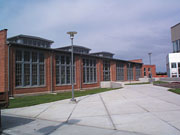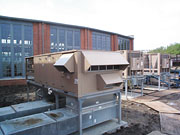
The approximately 20,000-square-foot roundhouse had to be completely gutted first. In addition, a large tract of land adjacent to the roundhouse was cleared for the construction of a 100,000-square-foot printing facility. The new facilities will be part of the Westside Business Park.
The project began about a year ago, and was in its finishing stages at the end of April 2002.
ROOFTOPS ARE GROUNDED
When DST Output decided on the location of its facility, it already knew the type of HVAC system it wanted: York rooftop units and a “FlexSys” underfloor air distribution system. The company had already had good luck with this combination of equipment in a previous building, and wanted The Fagan Company, Kansas City, KS, to repeat the system in the roundhouse.“The first system worked out very well, and they were happy with this type of equipment. They asked us to see if it could fit their budget, which it did,” says Bill Fagan, executive vice president, The Fagan Company. “We put the underfloor system in the roundhouse with the rooftop units, then standard ductwork and rooftop units in the new manufacturing facility.”
Due to structural and aesthetic limitations, it was necessary to place the rooftop units on the ground instead of on the roof. “Rather than sitting on a roof curb, the rooftop units sit on structural steel. They’re on grade level and ducted into the side of the building, serving the floor plenum from the side as opposed to dropping straight down through the roof through a shaft,” says Quentin McArthur, sales manager, McQueeny-Lock Co., Kansas City, MO.
The roundhouse is being served by four rooftop units: one 25-ton Millennium unit and one 50-ton and two 60-ton Eco2 units. The Millennium is cooling the lunchroom and is not serving the underfloor air conditioning. The three larger units were modified slightly at the factory to work with the underfloor system.
“When you air condition from underfloor as opposed to overhead, you use higher air temperatures. So, there are some minor modifications made to the Eco2 units to meet the need of higher air temperatures. If you’re going to use a rooftop unit with underfloor air conditioning, you just don’t pull one off the shelf; you need one that’s been modified to go with underfloor air conditioning,” says McArthur.
Fagan adds that since the system requires higher supply air temperatures, less tonnage is required than in traditional loads. Also, smaller compressors mean less electricity is used than traditional loads. This results in lower long-term operating costs. “This is a very friendly system to the owner,” notes Fagan.
With the units on the ground, it was necessary to take into consideration the ductwork coming from the rooftop into the building, as it was somewhat visible. Special screening and brickwork were put in place to hide the equipment for architectural purposes.

UNDERFLOOR ADVANTAGES
The underfloor air distribution system was especially attractive to the client, because it is very flexible. If people or desks are moved around the space, it’s possible to move the floor grilles along with them.“With the underfloor system, we used a combination of manual floor dampers and floor dampers with controls on the perimeter to give people air where they want to have it. We have the ability to move around the floor tile with these floor grilles in them. In case a desk moves over five feet, we can move the floor tile with them,” notes Fagan.
With heating grilles placed strategically under the windows, it is also possible to wash the large amounts of glass that were installed. This will help reduce fogging and condensation in wintertime.
Fagan is a big proponent of underfloor systems, noting that they offer numerous advantages. First, they are flexible. Second, the system has tax advantages because it becomes part of the floor, and therefore, part of the building. Third, the long-term operating costs are much lower than those usually found with traditional ductwork.
In addition, there is no ductwork to look at. It is located under the floor. In a retrofit situation, the underfloor system is actually installed over an existing floor, and usually raises the floor by 12 to 14 inches. Many building owners then take out the ceiling tile and associated ductwork to gain back that foot.
The system worked especially well in the roundhouse, because the building has an unusually high ceiling with exposed beams and columns. The architect wanted to retain that rustic look without the ductwork interfering with the aesthetics.
McArthur notes the underfloor system can work well in other applications. “Someone selects an underfloor system because of the flexibility required inside the space or the degree of cable management needed in the space in order to have a livable and sustainable office space. York’s ability to manufacture a rooftop unit to work specifically with the underfloor system makes the whole system much more applicable to a variety of spaces.”
Publication date: 06/24/2002


Report Abusive Comment